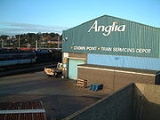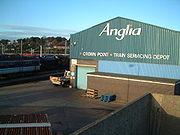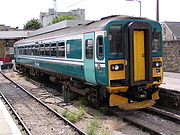
Anglia Railways
Encyclopedia
Anglia Railways was a British train operating company, owned by GB Railways
, which between 5 January 1997 and 31 March 2004 operated mainline trains out of London Liverpool Street station
and a number of local rail services in East Anglia
.
GB Railways
won the franchise because it offered to operate the franchise for the lowest subsidy. It also made a commitment to increase mainline services, which until then operated hourly between London
and Norwich
, to half hourly. The half hourly service to Norwich was introduced in 2000. GB Railways
ordered a fleet of Class 170 trains, although the services were operated initially using leased Class 317
trains because the manufacturer delivered the new trains late. Use of diesel multiple unit
train also allowed the company to introduce direct services to London
from towns off the electrified main line, including Sheringham
, Lowestoft
and Great Yarmouth
. It also introduced an experimental service outside of the territory inherited with the franchise. The service was called "London Crosslink
" and ran from the Great Eastern Main Line
via the North London Line
to Basingstoke
. This service ran from 30 May 2000 to 28 September 2002. Anglia Railways also introduced a highly successful direct service between Norwich and Cambridge using a two-car Class 170 diesel multiple unit. This service continues to run today.
 On 1 April 2004 its franchise was transferred to Train Operating Company London Eastern Railway Ltd, which is a subsidiary of the National Express Group
On 1 April 2004 its franchise was transferred to Train Operating Company London Eastern Railway Ltd, which is a subsidiary of the National Express Group
. Its services were initially branded 'one' and have since been rebranded as National Express East Anglia.
The decision to transfer the franchise to National Express was controversial, since Anglia was twice awarded "Train Operator of the Year
" and also "European Train Operator of Year 2000". Anglia Railways was very popular with passengers, its parent company GB Railways, was purchased by First Group, operator of First Great Eastern
, who had won the "Train Operator of the Year
" award once as well. National Express on the other hand had a reputation for poor service (Central Trains).
GB Railways
GB Railways was a company created in 1995 by Michael Schabas, Jeremy Long, Jim Morgan and Max Steinkopf to bid for British railway franchises. The company won the Anglia Railways rail franchise in 1997. In 1999 it successfully acquired the passenger services of Australian National Railways, in a...
, which between 5 January 1997 and 31 March 2004 operated mainline trains out of London Liverpool Street station
Liverpool Street station
Liverpool Street railway station, also known as London Liverpool Street or simply Liverpool Street, is both a central London railway terminus and a connected London Underground station in the north-eastern corner of the City of London, England...
and a number of local rail services in East Anglia
East Anglia
East Anglia is a traditional name for a region of eastern England, named after an ancient Anglo-Saxon kingdom, the Kingdom of the East Angles. The Angles took their name from their homeland Angeln, in northern Germany. East Anglia initially consisted of Norfolk and Suffolk, but upon the marriage of...
.
GB Railways
GB Railways
GB Railways was a company created in 1995 by Michael Schabas, Jeremy Long, Jim Morgan and Max Steinkopf to bid for British railway franchises. The company won the Anglia Railways rail franchise in 1997. In 1999 it successfully acquired the passenger services of Australian National Railways, in a...
won the franchise because it offered to operate the franchise for the lowest subsidy. It also made a commitment to increase mainline services, which until then operated hourly between London
London
London is the capital city of :England and the :United Kingdom, the largest metropolitan area in the United Kingdom, and the largest urban zone in the European Union by most measures. Located on the River Thames, London has been a major settlement for two millennia, its history going back to its...
and Norwich
Norwich
Norwich is a city in England. It is the regional administrative centre and county town of Norfolk. During the 11th century, Norwich was the largest city in England after London, and one of the most important places in the kingdom...
, to half hourly. The half hourly service to Norwich was introduced in 2000. GB Railways
GB Railways
GB Railways was a company created in 1995 by Michael Schabas, Jeremy Long, Jim Morgan and Max Steinkopf to bid for British railway franchises. The company won the Anglia Railways rail franchise in 1997. In 1999 it successfully acquired the passenger services of Australian National Railways, in a...
ordered a fleet of Class 170 trains, although the services were operated initially using leased Class 317
British Rail Class 317
The British Rail Class 317 alternating current electric multiple units were built by BREL York in two batches, from 1981-82 and 1985-87. They were the first of several classes of British Rail EMU to be based on the all-steel Mark 3 bodyshell, departing from the "PEP"-aluminium design which had...
trains because the manufacturer delivered the new trains late. Use of diesel multiple unit
Diesel multiple unit
A diesel multiple unit or DMU is a multiple unit train consisting of multiple carriages powered by one or more on-board diesel engines. They may also be referred to as a railcar or railmotor, depending on country.-Design:...
train also allowed the company to introduce direct services to London
London
London is the capital city of :England and the :United Kingdom, the largest metropolitan area in the United Kingdom, and the largest urban zone in the European Union by most measures. Located on the River Thames, London has been a major settlement for two millennia, its history going back to its...
from towns off the electrified main line, including Sheringham
Sheringham
Sheringham is a seaside town in Norfolk, England, west of Cromer.The motto of the town, granted in 1953 to the Sheringham Urban District Council, is Mare Ditat Pinusque Decorat, Latin for "The sea enriches and the pine adorns"....
, Lowestoft
Lowestoft
Lowestoft is a town in the English county of Suffolk. The town is on the North Sea coast and is the most easterly point of the United Kingdom. It is north-east of London, north-east of Ipswich and south-east of Norwich...
and Great Yarmouth
Great Yarmouth
Great Yarmouth, often known to locals as Yarmouth, is a coastal town in Norfolk, England. It is at the mouth of the River Yare, east of Norwich.It has been a seaside resort since 1760, and is the gateway from the Norfolk Broads to the sea...
. It also introduced an experimental service outside of the territory inherited with the franchise. The service was called "London Crosslink
London Crosslink
London Crosslink was a train service operated by Anglia Railways, which ran between Norwich and Basingstoke, using the North London Line to by-pass central London. Class 170 "Turbostar" diesel multiple units were used. The service ran from 30 May 2000 to 11 September 2002...
" and ran from the Great Eastern Main Line
Great Eastern Main Line
The Great Eastern Main Line is a 212 Kilometre major railway line of the British railway system, which connects Liverpool Street in the City of London with destinations in east London and the East of England, including Chelmsford, Colchester, Ipswich, Norwich and several coastal resorts such as...
via the North London Line
North London Line
The North London Line is a railway line which passes through the inner suburbs of north London, England. Its route is a rough semicircle from the south west to the north east, avoiding central London. The line is owned and maintained by Network Rail...
to Basingstoke
Basingstoke railway station
Basingstoke railway station, in the town of Basingstoke in the county of Hampshire in England, is on the South Western Main Line from London Waterloo, with local and fast services operated by South West Trains. It is also the terminus of First Great Western local services on the Reading to...
. This service ran from 30 May 2000 to 28 September 2002. Anglia Railways also introduced a highly successful direct service between Norwich and Cambridge using a two-car Class 170 diesel multiple unit. This service continues to run today.

National Express Group
National Express Group plc is a British transport group headquartered in Birmingham that operates bus, coach, rail and tram services in the UK, the US and Canada, Spain, Portugal and Morocco and long-distance coach routes across Europe...
. Its services were initially branded 'one' and have since been rebranded as National Express East Anglia.
The decision to transfer the franchise to National Express was controversial, since Anglia was twice awarded "Train Operator of the Year
Train Operator of the Year
Train Operator of the Year is a rail transport industry award to recognize excellence among train operating companies of the United Kingdom. The award has been presented as part of the HSBC Rail Business Awards since 1997....
" and also "European Train Operator of Year 2000". Anglia Railways was very popular with passengers, its parent company GB Railways, was purchased by First Group, operator of First Great Eastern
First Great Eastern
First Great Eastern was an award-winning train operating company that operated suburban, local and medium distance train services from London Liverpool Street via Romford to Essex and Ipswich in the United Kingdom on the Great Eastern Main Line railway.First Group gained the Great Eastern...
, who had won the "Train Operator of the Year
Train Operator of the Year
Train Operator of the Year is a rail transport industry award to recognize excellence among train operating companies of the United Kingdom. The award has been presented as part of the HSBC Rail Business Awards since 1997....
" award once as well. National Express on the other hand had a reputation for poor service (Central Trains).
Fleet
| Class | Image | Type | Top speed | Number | Built | |
|---|---|---|---|---|---|---|
| mph | km/h | |||||
| Class 47 British Rail Class 47 The British Rail Class 47, is a class of British railway diesel-electric locomotive that was developed in the 1960s by Brush Traction. A total of 512 Class 47s were built at Crewe Works and Brush's Falcon Works, Loughborough between 1962 and 1968, which made them the most numerous class of British... |
 |
Diesel locomotive Diesel locomotive A diesel locomotive is a type of railroad locomotive in which the prime mover is a diesel engine, a reciprocating engine operating on the Diesel cycle as invented by Dr. Rudolf Diesel... |
100 | 160 | Hired from Cotswold Rail Cotswold Rail thumb|right|[[British Rail Class 47|Class 47]], no. 47316 'Cam Peak', at [[Doncaster railway works|Doncaster Works]] open day on 27th July 2003. This locomotive had recently been returned to traffic after a period in store... |
1962–1968 |
| Class 86 British Rail Class 86 The British Rail Class 86 was the standard electric locomotive built during the 1960s, developed as a result of testing with the earlier Classes 81, 82, 83, 84 and 85. One hundred of these locomotives were built from 1965-1966 by either English Electric at Vulcan Foundry, Newton-le-Willows, or... |
 |
Electric locomotive Electric locomotive An electric locomotive is a locomotive powered by electricity from overhead lines, a third rail or an on-board energy storage device... |
100 | 160 | 15 | 1965-1966 |
| Class 150 Sprinter British Rail Class 150 The British Rail Class 150 "Sprinter" diesel multiple units were built by BREL from 1984-87. A total of 137 units were built in three main subclasses, replacing many of the earlier first-generation "Heritage" DMUs.- Background :... |
 |
Diesel multiple unit Diesel multiple unit A diesel multiple unit or DMU is a multiple unit train consisting of multiple carriages powered by one or more on-board diesel engines. They may also be referred to as a railcar or railmotor, depending on country.-Design:... |
75 | 120 | 10 | 1984–1987 |
| Class 153 Super Sprinter British Rail Class 153 The British Rail Class 153 Super Sprinter is a single car diesel multiple unit converted from British Rail Class 155s.-Description:These units were originally built as two-car Class 155 units by British Leyland from 1987–88, but were converted by Hunslet-Barclay at Kilmarnock from 1991-92... |
 |
Diesel multiple unit Diesel multiple unit A diesel multiple unit or DMU is a multiple unit train consisting of multiple carriages powered by one or more on-board diesel engines. They may also be referred to as a railcar or railmotor, depending on country.-Design:... |
75 | 120 | 7 | 1987–1988 |
| Class 170 Turbostar |  |
Diesel multiple unit Diesel multiple unit A diesel multiple unit or DMU is a multiple unit train consisting of multiple carriages powered by one or more on-board diesel engines. They may also be referred to as a railcar or railmotor, depending on country.-Design:... |
100 | 160 | 12 | 1999–2002 |
| Mark 2 coach British Rail Mark 2 The Mark 2 family of railway carriages were British Rail's second design of carriages. They were built by British Rail workshops between 1964 and 1975... |
 |
Passenger Passenger A passenger is a term broadly used to describe any person who travels in a vehicle, but bears little or no responsibility for the tasks required for that vehicle to arrive at its destination.... Rolling stock Rolling stock Rolling stock comprises all the vehicles that move on a railway. It usually includes both powered and unpowered vehicles, for example locomotives, railroad cars, coaches and wagons... |
100 | 160 | 115 | 1964–1975 |
 |
DBSO Control Car Control car (rail) A control car is a generic term for a non-powered railroad vehicle that can control operation of a train from the end opposite to the position of the locomotive... |
100 | 160 | 13 | 1979-1986 | |

